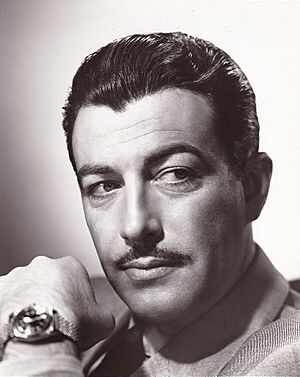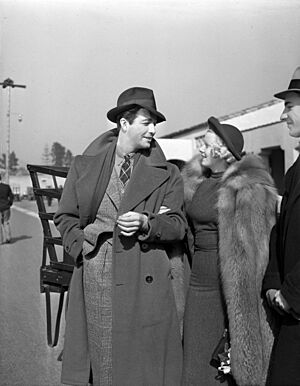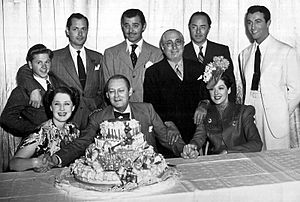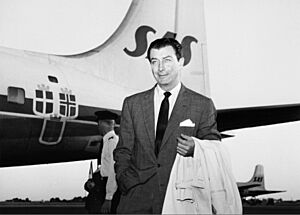Robert Taylor (American actor) facts for kids
Quick facts for kids
Robert Taylor
|
|
|---|---|

Taylor in 1946
|
|
| Born |
Spangler Arlington Brugh
August 5, 1911 Filley, Nebraska, U.S.
|
| Died | June 8, 1969 (aged 57) Santa Monica, California, U.S.
|
| Resting place | Forest Lawn Memorial Park, Glendale, California |
| Alma mater | Doane College Pomona College |
| Occupation | Actor |
| Years active | 1934–1968 |
| Spouse(s) | |
| Children | 3 |
Robert Taylor (born Spangler Arlington Brugh; August 5, 1911 – June 8, 1969) was a famous American actor. He starred in many movies and TV shows. He was known as one of the most popular leading men in Hollywood.
Robert Taylor started acting in films in 1934. He signed a contract with Metro-Goldwyn-Mayer (MGM), a big movie studio. His first main role was in the film Magnificent Obsession in 1935. He became very popular in the late 1930s and 1940s. Some of his well-known movies include Camille (1936) and Waterloo Bridge (1940).
During World War II, he served in the United States Navy. He was a flight instructor and appeared in training films. Later, he starred in the TV series The Detectives Starring Robert Taylor from 1959 to 1962. In 1966, he became the host of the show Death Valley Days.
Taylor was married to actress Barbara Stanwyck from 1939 to 1952. He later married actress Ursula Thiess in 1954. They had two children together. Robert Taylor passed away at age 57.
Robert Taylor's Early Life and Education
Robert Taylor was born Spangler Arlington Brugh on August 5, 1911. His birthplace was Filley, Nebraska. He was the only child of Ruth Adaline and Spangler Andrew Brugh. His father was a doctor.
His family moved several times when he was young. They lived in places like Muskogee, Oklahoma and Fremont, Nebraska. By 1917, they settled in Beatrice, Nebraska for 16 years.
As a teenager, Robert was a talented athlete in track and field. He also played the cello in his high school orchestra. After high school, he went to Doane College in Crete, Nebraska. He continued his cello lessons there.
When his cello teacher moved to Pomona College in California, Robert followed. He joined the college's theater group. In 1932, a talent scout from MGM saw him in a play. This led to his big break in Hollywood.
Robert Taylor's Acting Career
Robert Taylor signed a seven-year contract with Metro-Goldwyn-Mayer (MGM). He started with a salary of $35 per week. By 1936, it had increased to $2500 per week. The studio changed his name to Robert Taylor.
His first movie was the comedy Handy Andy in 1934. His first main role happened by chance. He was working as a "test boy" for MGM. This meant he acted opposite young actresses for screen tests.
In late 1934, an actor in a short film called Buried Loot got sick. Robert Taylor stepped in to replace him. His strong performance in this film impressed the studio. He was then quickly given roles in bigger movies.
In 1935, actress Irene Dunne chose him to be her co-star in Magnificent Obsession. After this, he acted alongside the famous Greta Garbo in Camille.


Throughout the late 1930s, Taylor appeared in different types of films. These included musicals like Broadway Melody of 1936. He also starred in the British comedy A Yank at Oxford with Vivien Leigh.
In 1940, he worked with Vivien Leigh again in the drama Waterloo Bridge. He was known as "The Man with the Perfect Profile." After 1941, he started taking on more serious roles. He played the main character in Billy the Kid in 1941. The next year, he starred in Johnny Eager with Lana Turner.
Robert Taylor's War Service and Later Films
After playing a tough sergeant in Bataan in 1943, Taylor joined the war effort. He became a flying instructor in the U.S. Naval Air Corps. He also appeared in training films and narrated a documentary called The Fighting Lady in 1944.
After the war, he continued to act in intense roles. These included Undercurrent (1946) and High Wall (1947). In 1949, he co-starred with Elizabeth Taylor in Conspirator.
In 1950, Robert Taylor got the role of General Marcus Vinicius in Quo Vadis. This epic film was a huge success. The next year, he starred in Ivanhoe. He also appeared in Knights of the Round Table (1953). These films were made in England.
By the mid-1950s, Taylor focused on western films. This was his favorite type of movie. He starred in Many Rivers to Cross in 1955. His long career at MGM ended in 1959. He was one of the last big stars from the studio's golden age.
Taylor started his own company, Robert Taylor Productions. He starred in the TV series The Detectives Starring Robert Taylor from 1959 to 1962. After this, he continued to appear in movies and TV shows.
In 1964, he acted with his former wife, Barbara Stanwyck, in The Night Walker. In 1965, he became the narrator for the TV series Death Valley Days. He took over from Ronald Reagan, who left to go into politics. Taylor stayed with the show until he passed away in 1969.
Robert Taylor's Personal Life
Marriages and Children
Robert Taylor married actress Barbara Stanwyck on May 14, 1939. They had been dating for three years. Stanwyck's adopted son, Anthony "Tony" Dion, lived with them. They divorced in February 1951. Stanwyck kept custody of Tony.
Taylor met German actress Ursula Thiess in 1952. They got married on May 23, 1954. They had two children together: a son named Terrance (born 1955) and a daughter named Tessa (born 1959). Robert was also a stepfather to Ursula's two children from her previous marriage.
Robert Taylor's Political Views
In February 1944, Robert Taylor helped create the Motion Picture Alliance for the Preservation of American Ideals. This group was against communism in Hollywood. In October 1947, Taylor was asked to speak before the House Committee on Un-American Activities. This committee was investigating communism in the film industry.
Taylor said that some actors seemed to be communists or supported them. He stated he would not work with anyone suspected of being a communist. After his testimony, his films were banned in some communist countries.
In 1951, Taylor explained his views. He said he spoke out against communism for the same reason he spoke against Nazism. He believed in freedom and decency. He also helped narrate a documentary in 1952 called The Hoaxters. This film compared communism to Nazism.
Taylor supported Barry Goldwater in the 1964 presidential election. He also supported Ronald Reagan in the 1966 California governor election.
Robert Taylor's Love for Flying
In 1952, Taylor starred in the film Above and Beyond. This movie was about Enola Gay pilot Paul Tibbets. Taylor and Tibbets became friends. They both loved flying and skeet shooting.
Taylor learned to fly in the mid-1930s. He served as a flying instructor in the U.S. Navy during World War II. He owned a private plane called "Missy." He used it for hunting trips and to fly to movie locations.
Robert Taylor's Ranch Home
Robert Taylor owned a large 34-room house. It was located on 112 acres in Mandeville Canyon in Los Angeles. This property was known as the Robert Taylor Ranch.
The ranch was sold after his death. In 2010, it was taken over by a financial company. In 2012, the Robert Taylor Ranch was put up for auction. It was bought for $12 million.
Robert Taylor's Death
Robert Taylor passed away from lung cancer on June 8, 1969. He died at Saint John's Health Center in Santa Monica, California.
His funeral was held at Forest Lawn Memorial Park Cemetery. His friend Ronald Reagan, who was then the governor of California, gave a speech. Many famous actors attended the funeral. These included Barbara Stanwyck, Robert Stack, and Mickey Rooney.
Robert Taylor has a star on the Hollywood Walk of Fame. It is located at 1500 Vine Street. This star honors his contributions to the film industry.
Filmography
| Year | Title | Role | Notes |
|---|---|---|---|
| 1934 | Handy Andy | Lloyd Burmeister | |
| 1934 | There's Always Tomorrow | Arthur White | |
| 1935 | Magnificent Obsession | Dr. Robert Merrick | |
| 1936 | Small Town Girl | Dr. Robert "Bob" Dakin | |
| 1936 | Camille | Armand Duval | |
| 1937 | Personal Property | Raymond Dabney | |
| 1938 | A Yank at Oxford | Lee Sheridan | |
| 1938 | Three Comrades | Erich Lohkamp | |
| 1939 | Stand Up and Fight | Blake Cantrell | |
| 1940 | Waterloo Bridge | Roy Cronin | |
| 1941 | Billy the Kid | Billy Bonney | |
| 1942 | Johnny Eager | John "Johnny" Eager | |
| 1943 | Bataan | Sergeant Bill Dane | |
| 1946 | Undercurrent | Alan Garroway | |
| 1947 | High Wall | Steven Kenet | |
| 1949 | Conspirator | Major Michael Curragh | |
| 1950 | Ambush | Ward Kinsman | |
| 1950 | Devil's Doorway | Lance Poole | |
| 1951 | Quo Vadis | Marcus Vinicius | |
| 1952 | Ivanhoe | Sir Wilfred of Ivanhoe | |
| 1952 | Above and Beyond | Lieutenant Colonel Paul W. Tibbets | |
| 1953 | Ride, Vaquero! | Rio | |
| 1953 | Knights of the Round Table | Lancelot | |
| 1954 | Valley of the Kings | Mark Brandon | |
| 1955 | Many Rivers to Cross | Bushrod Gentry | |
| 1956 | The Last Hunt | Charlie Gilson | |
| 1956 | D-Day the Sixth of June | Captain Brad Parker | |
| 1958 | The Law and Jake Wade | Jake Wade | |
| 1958 | Party Girl | Thomas "Tommy" Farrell | |
| 1959 | The Hangman | Mackenzie Bovard | |
| 1960 | Killers of Kilimanjaro | Robert Adamson | |
| 1963 | Miracle of the White Stallions | Colonel Podhajsky | |
| 1963 | Cattle King | Sam Brassfield | |
| 1964 | The Night Walker | Barry Morland | |
| 1966 | Johnny Tiger | George Dean | |
| 1966 | Savage Pampas | Captain Martin | |
| 1967 | The Glass Sphinx | Prof. Karl Nichols | |
| 1967 | Return of the Gunfighter | Ben Wyatt | |
| 1968 | The Day the Hot Line Got Hot | Anderson |
| Year | Title | Role | Notes |
|---|---|---|---|
| 1959–1962 | The Detectives Starring Robert Taylor | Det. Capt. Matt Holbrook | 97 episodes |
| 1966–1969 | Death Valley Days | Host | 77 episodes |
| Year | Program | Episode/source |
|---|---|---|
| 1942 | The Screen Guild Theater | My Favorite Wife |
| 1943 | Lux Radio Theatre | The Philadelphia Story |
| 1945 | Suspense | The Argyle Album |
| 1946 | The Screen Guild Theater | Waterloo Bridge |
| 1946 | Suspense | The House in Cypress Canyon |
See also
 In Spanish: Robert Taylor (actor) para niños
In Spanish: Robert Taylor (actor) para niños


